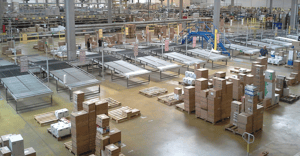What’s the point in having adhesive tape if you don’t know how to properly store it?
Storing adhesive tape is an essential part of material handling and die cut converting, but there’s a lot more to consider than simply stacking it on a shelf and calling it good.
Knowing the Right Conditions
The weather dramatically impacts the behavior of different materials, especially factors like humidity or temperature.
If you’re lucky, production happens in an area with a handy thermostat on the wall. Still, whether you have direct control over the humidity or temperature, you can take many additional precautions.
HUMIDITY
Humidity is one of the most crucial conditions to monitor when storing adhesive tape.
For instance, too much moisture in certain “hygroscopic” materials can lead to swelling, which ultimately skews the measurements of your final product.
These are the most common hygroscopic materials:
- Nylon
- ABS
- Acrylic
- PET with glycol additives
- Polyurethane
- Polycarbonate
Another primary reason to combat humidity in converting is to prevent the material from becoming too soft and wet to process.
Too much humidity can turn adhesives gooey, causing them to nearly ooze off a die cut press.
The right converter already knows how to combat excess humidity, typically through desiccant packaging.
Desiccant packaging combats humidity that might cause damage to the product. One example is silica gel packets, which manufacturers toss in boxes to protect electronics or clothes during shipping.
Another piece of desiccant packaging is desiccant tubes, which Strouse uses to package humidity-sensitive diabetes test strips.
Hydrogel is mainly made from water and is prone to drying up.
Your converter might take steps like sealing the product right away to prevent it from drying out.
TEMPERATURE
Warm temperatures can have similar effects on adhesives as too much humidity, causing them to grow pliant and soft.
Storing tape in a warm environment can be more difficult due to the adhesive’s tendency to seep. If the adhesive rolls continue touching, they might seep into one another over time.
Aside from installing fans or cranking down the thermostat, converters can manage the summer heat by freezing adhesive tape.
Storing adhesive tape in freezers makes some adhesives easier to work with by preventing the rolls from stretching and giving them a more brittle texture.
Freezing also minimizes the adhesive from catching on the back of the liner and causing inconsistencies like bubbles, gaps, or wavering from occurring along the edges.
Storage & Converting
Keeping your adhesive tape in good condition is beneficial for converting.
Think of it like this, IMPERFECT tape creates IMPERFECT parts.
If you keep your materials pristine, there’s a much higher chance you’ll achieve your desired results.
HOLDING ITS SHAPE
Materials in a warehouse are stacked, and stacked rolls can flatten over time depending on the material.
Unfortunately, maintaining the shape of tape rolls is crucial to die cut automation.
Bent, flattened, or otherwise warped rolls of adhesive tape are significantly more challenging to process. If the damage is too severe, those rolls might be a lost cause entirely.
So, how can we prevent this?
Packaging your tapes as safely as possible will hold them in the proper shape no matter how long they sit on the shelf.
Two tools that guarantee the shape of your tape are cores and caps.
Cores are solid tubes that hold the tape roll in their ideal, circular position.
Adhesive caps go on either end, preventing the tape from bending under the weight of other rolls.
Lastly, how you stack your tape could affect its lifetime if you aren’t careful.
Stacking tape upright instead of horizontally could place uneven pressure on the rolls underneath and cause deformation.
Automation might not be at the top of your priority list, but if you want to save money by ordering materials in bulk, you’ll want to keep those tape rolls in good shape for a long time.
KEEPING IT CLEAN
Adhesive tape has to remain clean to retain its stickiness.
During shipping, tape rolls can be wrapped in plastic or boxed to keep out particles.
However, the most convenient option for storing tape rolls is using silicone rings to protect the sticky ends.
Seeping is inevitable: It happens due to gravity, and it causes rolls to bond together over time, making them impossible to separate. Separators are a necessity.
Silicone rings are slid onto or stacked on top of tape rolls to function as dividers. They can prevent the adhesive from seeping together and gluing together rolls.
WHY IT MATTERS
Poorly stored material can delay or cause issues when used for a project.
Material can be expensive and hard to pick out, so you need a converter you can trust to keep it safe once it arrives for processing.
Not every adhesive tape needs special treatment but having a converter who knows exactly which materials require more care could save you lots of money from potential wasted material.
Feel free to ask us if you have questions about how Strouse handles materials or if you want to get started on a quote today!





